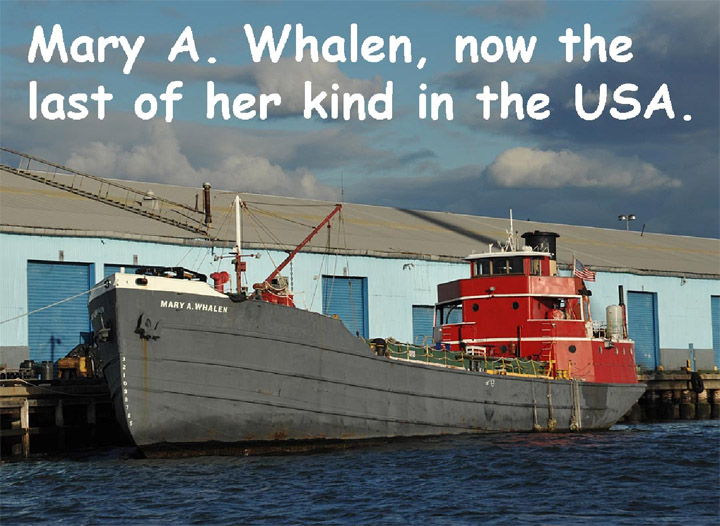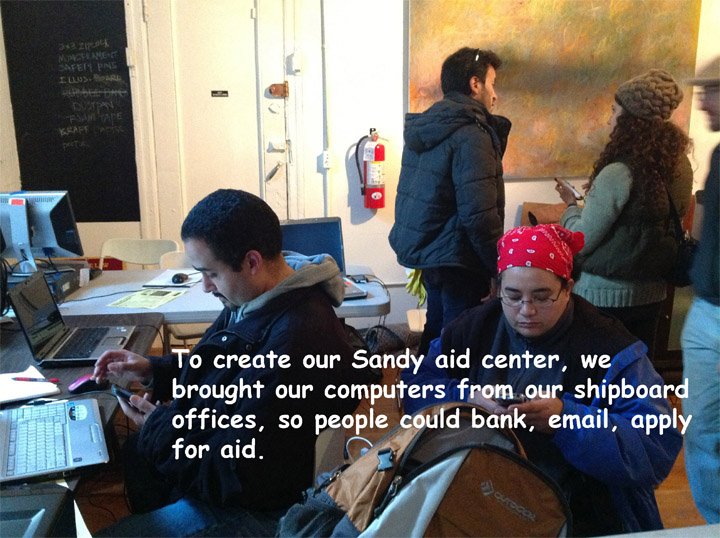This story was written collaboratively by the PortSide team Dan Goncharoff, Peter Rothenberg, Carolina Salguero and John Weaver. Andrea Sansom provided recommendations about the overall message and editing advice.

PortSide NewYork has been invited by the Red Hook Star Revue to tell our Sandy story, a story largely hidden, like so many in Red Hook. We believe our story offers hope and guidance for the future. That’s because our maritime perspective explains how we knew to prepare for Sandy, made us available to help Red Hook’s Sandy recovery, and is a knowledge base we want to share to make you safer from floods in the future.
PortSide NewYork was founded to help change awareness and use of NYC’s BLUEspace, the water part of the waterfront. New York City’s area is one third water, and contains 29 islands. PortSide’s goal is to create a place that will showcase what NYC’s waterfront can really be. Our ship, the tanker MARY A. WHALEN, is an ambassador in that goal and our endeavor to bring the community ashore and the community afloat, the maritime community, closer together. Here’s our Sandy story:
Sandy prevention: Saving a historic ship
Thursday, 10/25/12, 1pm, Sandy minus 4.5 days, PortSide’s crew said good-bye to a class trip of first graders visiting the MARY A. WHALEN and started hurricane prep, punching our way thru the list of what we did for Irene the year before.
During the next four and a half days, we traded strategies with historic ships and modern workboats around the harbor. We all laid in food, water and fuel; tested generators; and moved our boats to safer places. PortSide curator Peter Rothenberg, shipcat Chiclet and Director Carolina Salguero are storm crew on the MARY A. WHALEN.
The maritime community obsessively followed marine weather reports. “Grim installments are burned in my memory,” said Carolina Salguero. “At Sandy minus 1.5 days, we learned an 8-foot surge is coming. At Sandy minus a few hours, I am readying for a 12 foot surge.”
Ashore in Red Hook, things were different. Sunday night, Sandy minus 24 hours, an email blast went out telling Red Hook which bars will be open and what movies are being screened. Carolina worried, “Is the community ashore prepping for Sandy? Has anyone evacuated?” PortSide’s maritime world felt separated from neighbors ashore by more than the containerport fence.
Peter Rothenberg was valiant. “When Carolina got word that the storm surge was expected to be 12 or 13 feet high, I had visions of the MARY tipping over onto the pier and emphatically agreed with the idea of securing a preventer line to the next pier 265 feet away.”
Due to preparations, our ship MARY WHALEN safely rode out the surge with our office aboard, enabling every form of Sandy assistance we delivered to Red Hook afterwards.
Peter and Carolina came ashore on Wednesday afternoon to discover a devastated Red Hook, and immediately decided that PortSide’s urgent search for a publicly-accessible homeport was flooded to a standstill and that we would help Red Hook until waterfront sites recovered enough for us to resume real estate talks.
Appreciation from Red Hook
Adam Armstrong, Pioneer Street resident and writer of the blog “View from the Hook” describes what happened next, “PortSide came ashore, quickly set up shop at 351 Van Brunt Street and proceeded to make a base – a visible and accessible storefront – from where they could reach out, provide information, resources and assistance to their land lubbing neighbors, most of us who were desperately trying to recover from the immense damage that had been done to our homes and our unique, waterfront neighborhood. Carolina Salguero and her team of volunteers co-ordinated clean-out crews and tradesmen to go and physically assist our residents, and they gathered and disseminated information about anything they though would be helpful – FEMA, legal assistance, insurance matters, Con Edison, National Grid, the Rapid Repairs program, etc., and provided a connection to our representatives in government. On many of these matters, PortSide organized meetings and reached out to our residents, and in the case of our street – Pioneer Street – Carolina co-ordinated the creation of a comprehensive contact list so that everyone on our block could share information and provide support to each other. It was – and still is – a wonderful way for the residents of Pioneer Street to keep in touch and get updates on our street’s recovery.”
What made that work possible was the selflessness of three people PortSide is honoring at our fundraiser on Tuesday, October 28 at Hometown. Victoria Hagman donated Realty Collective’s storefront and utilities at 351 Van Brunt, despite suffering extensive flood damage herself. Park Slope electrician Danny Schneider walked into 351 and offered free labor. PortSide coordinated his work, and Danny reports that he inspected and certified 60 buildings and repaired some two dozen for just the cost of parts.
Our third honoree, our Curator Peter Rothenberg worked both ends of PortSide’s recovery story, the prevention that saved the MARY WHALEN and the aid work after the storm of setting up and running 351.
Peter, Carolina and Dan Goncharoff of PortSide ran 351 for a month and then continued a virtual aid station and other recovery efforts out of view. In April 2013, PortSide won a White House award for Sandy recovery work, and in July, the New York State Senate honored our work.
PortSide work transitions from recovery to resiliency
Carolina began attending resiliency conferences. Summer 2013, she was asked to become a member of Red Hook’s NY Rising committee to create local resiliency plans. PortSide staff and interns did research supporting the committee during its eight months of work. One of Carolina’s NY Rising goals was to inject maritime issues into the discussion, hoping the State NY Rising process could influence a state agency, the Department of Environmental Conservation (DEC), so waterfront infrastructure in NYC can be more repaired and built for both resiliency and everyday operations. Carolina also proposed the solar-powered emergency lights for NYCHA housing which are in Red Hook’s plan and are being considered for other NYCHA developments. “I think the NY Rising committee work is good. Red Hook distinguished itself for what we put in our plan,” says Carolina; but plans are hidden assets for most people until they are built.
Looking back on PortSide’s two years of Sandy-related work, for the sake of Red Hook’s planning better for the future, we would like to talk about some hidden Sandy stories of need and success we found in the course of our recovery and resiliency work.
Hidden Sandy stories of need and success
PortSide’s recovery work helped many people who don’t get media coverage and whose cases deserve more attention: People without an advocacy group, without on-line fundraising. People who aren’t comfortable using computers and needed Peter’s help to complete digital forms. People in mixed-use buildings that don’t fit FEMA homeowner funding guidelines. Renters who are not in NYCHA, and so are not in the media and political spotlights. Seniors, immigrants. People whose divorce, estate and tax situations complicated filing for aid and kept them from speaking up in public meetings. People who are private about their needs in general.
We learned that some affordable flood prevention was possible: The owners of Metal & Thread used a few hundred dollars of hardware store supplies to keep water from coming into their storefront and through the sidewalk hatch — though their cellar suffered water leaking through the foundation from the empty lot next door. Some tugboat crews saved their cars by moving them from Erie Basin to the second floor garage at Home Depot, above surge level.
IKEA’s contribution needs more attention. IKEA gave and gave and got no media coverage until the Sandy’s one year anniversary when their $250,000 investment in solar powering the Rec Center netted some articles. 
The power of connecting the community ashore and community afloat
Inland Red Hook is so disconnected from maritime Red Hook that the latter’s role in recovery is not discussed. For example, Jim Tampakis’ business Marine Spares was significant in pumping out the Hugh L. Carey tunnel. Vane Brothers provided hoses to the Hess fuel terminal so home heating oil could be delivered. Both firms did that despite flood damage to their offices and mechanical shops.
PortSide feels the gap between inland resident and mariner is acute when we heard residents say “They told us to evacuate for Irene but nothing happened” and “I didn’t know there were two high tides a day.” We conclude that people ashore poorly understand marine weather reports and don’t know where to get them.
In comparison, mariners understand how to live with water, and how to prepare for hurricanes. They do the post-flood work of pumping tunnels, building ferry terminals and running emergency ferries, fixing bulkheads, clearing the harbor of debris so ships can import products as diverse as fuel, orange juice, new cars, bananas.
To bring maritime voices to people ashore, PortSide plans programs to help folks develop coastal living and flood prep skills, such as educational events with actual mariners, exhibits, and creating a children’s book with our shipcat Chiclet as a resiliency narrator talking about riding out Sandy on the tanker.
Andrea Sansom, who founded the Red Hook flood mitigation Google group, sees the need, “We all love living at the water, and PortSide is here to help bring understanding to living with the water.”
Our ship is a great tool for this. Our tanker MARY A. WHALEN is now a maritime symbol of resiliency, in contrast to the tanker JOHN B. CADDELL, Staten Island’s symbol of Sandy, which went aground and had to be scrapped.
PortSide’s own Sandy damages
A hidden Sandy story PortSide feels acutely is that of our own Sandy damages. An electrical short left us facing thirty-five nights of relying on flashlights and one 15-amp extension cord attached to a little gas generator. Sandy damaged the Sheepshead Bay house of our staffer John Weaver keeping him home for many months. Everything PortSide had off the ship (antique crane, 60’ dock, electrical transformer, restoration engine parts, historic artifacts and documents, special event equipment and furniture) was flood-damaged or floated away. Our FEMA worksheet totals some $340,000, and we are still deep in that paper chase, starting six months late because we were misinformed that we don’t qualify.
A massive Sandy effect on PortSide was the stalling of our urgent search for a homeport. We need a place to fulfill our mission, earn revenue, and run programs. Resumption of real estate negotiations took many, many more months than we expected, and remains a major strain on PortSide.
PortSide is now focused on the future while celebrating the good in recovery. Come join us in that spirit at our fundraiser on Tuesday, October 28 at Hometown Bar-B-Que. Join us in honoring our partners in Red Hook’s Sandy recovery: Victoria Hagman of Realty Collective, Danny Schneider the electrician, and Peter Rothenberg. Wear festive MARY WHALEN red and white. We look forward to talking with you there and, going forward, continuing the work we’ve collectively begun after Sandy in understanding our waterfront in all its complexity and potential!








